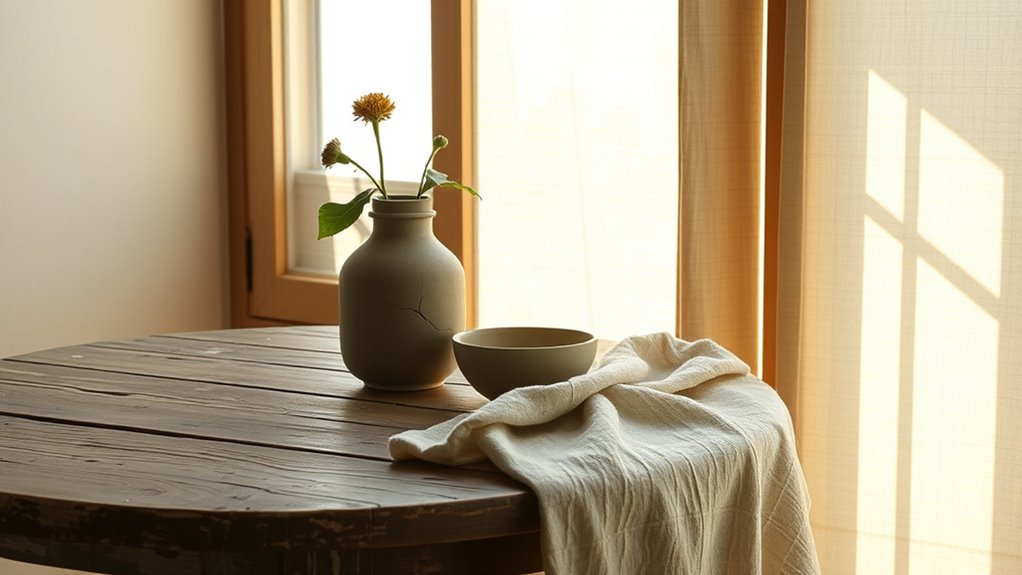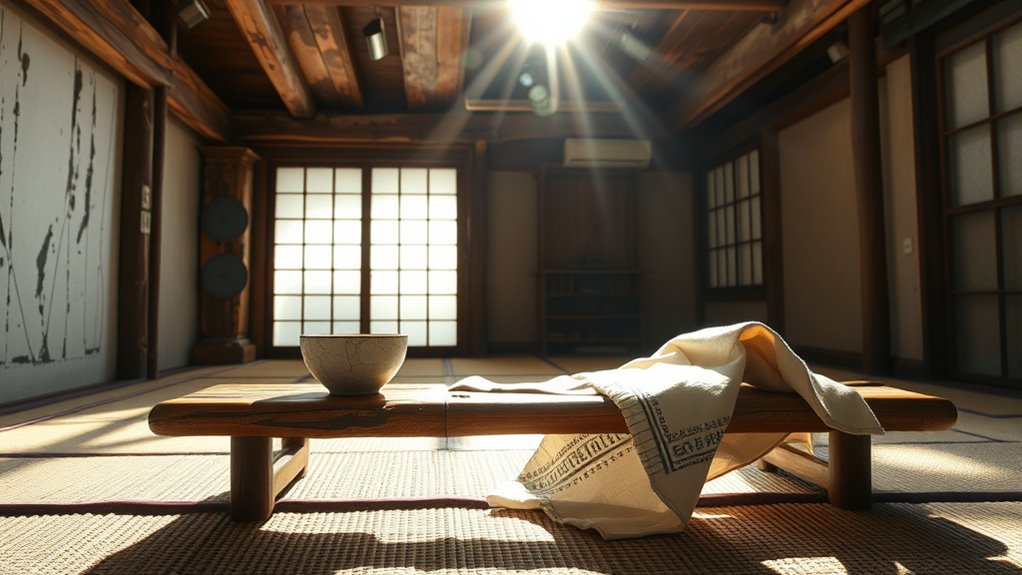Wabi-sabi living invites you to embrace imperfection and impermanence in your surroundings and mindset. Focus on appreciating subtle details, natural materials, and authentic character in everyday objects. Simplify your space to create calm and space for mindfulness. Recognize that flaws, wear, and aging add beauty and story. By embracing this philosophy, you’ll discover serenity in authenticity. To deepen your understanding of how to incorporate wabi-sabi into your life, explore further.
Key Takeaways
- Embrace imperfections and aging objects as authentic, beautiful elements that tell a story.
- Simplify spaces by removing excess, highlighting natural materials and subtle details.
- Focus on textures, shapes, and natural materials that evoke a sense of tranquility.
- Cultivate mindfulness and acceptance of transience to deepen appreciation of beauty over time.
- Use technology thoughtfully to enhance a minimalist environment aligned with wabi-sabi principles.

Wabi-sabi living invites you to embrace the beauty of imperfection and transience in everyday life. At its core, it’s about appreciating the subtle, often overlooked details that make life unique. This philosophy is rooted in Japanese aesthetics, which emphasize simplicity, naturalness, and the imperfect. When you adopt wabi-sabi principles, you start to see beauty in things that might otherwise be considered flawed or worn out. It’s a perspective shift that encourages you to slow down and value authenticity over perfection.
Incorporating minimalist design into your lifestyle aligns perfectly with wabi-sabi ideals. Minimalism strips away excess, leaving only what’s essential. It’s about creating space—both physically and mentally—to focus on what truly matters. When you combine minimalist design with Japanese aesthetics, your environment becomes a sanctuary of calm and understated elegance. Instead of cluttered, busy spaces, you craft a setting that celebrates natural materials, muted tones, and simple forms. This approach allows the imperfections in your surroundings—like a crack in a ceramic bowl or the uneven grain of wood—to stand out as features of character and history, not flaws to hide.
Living with a wabi-sabi mindset means you pay close attention to textures, shapes, and materials. You might choose handcrafted pottery that shows subtle imperfections or wear, recognizing that these qualities add a layer of authenticity and story. Your furniture and decor are intentionally kept simple, emphasizing clean lines and natural materials, which highlight their organic qualities. As you embrace the imperfect beauty of these items, you cultivate a sense of tranquility and acceptance within your space. This isn’t about perfectionism but about appreciating the fleeting nature of life and the beauty in its impermanence.
Practicing wabi-sabi in daily life encourages you to accept the aging process, the wear and tear of objects, and the transient moments that make life meaningful. It’s about finding joy in the present, rather than constantly chasing an ideal that’s elusive. When you adopt this mindset, your surroundings and your attitude shift toward patience and mindfulness. You recognize that beauty isn’t static; it evolves and deepens over time. By integrating Japanese aesthetics and minimalist design, you create a harmonious environment that reflects your appreciation for the imperfect, the transient, and the authentic. This, ultimately, is the essence of wabi-sabi living—finding profound beauty in life’s natural, imperfect flow. Additionally, utilizing AI technology can help personalize and enhance your minimalist lifestyle through tailored suggestions and smart home integration.
Frequently Asked Questions
How Can I Incorporate Wabi‑Sabi Into Modern Home Design?
To incorporate Wabi‑Sabi into your modern home design, focus on embracing handmade textures and natural color palettes. Use imperfect pottery, handcrafted textiles, and weathered wood to add character. Opt for neutral tones like earthy browns, soft grays, and warm beiges to create a calming atmosphere. Keep clutter minimal, and highlight the beauty of imperfection in your decor choices, fostering a serene, authentic space that celebrates simplicity and natural elegance.
What Are Common Materials Used in Wabi‑Sabi Decor?
You’ll find ceramic pottery and weathered wood are common materials in wabi-sabi decor. These materials emphasize natural beauty and imperfection, so you might choose handcrafted ceramics with uneven glazes or furniture with a distressed finish. Incorporate weathered wood for warmth and character, highlighting its natural grain and irregularities. By combining these elements, you create a space that celebrates authenticity and simplicity, embodying the essence of wabi-sabi.
How Does Wabi‑Sabi Influence Mental Well-Being?
You find that embracing imperfection encourages mindfulness practice, helping you stay present and appreciate simple moments. Wabi-sabi fosters emotional resilience by teaching you to accept flaws and life’s unpredictability. This perspective reduces stress and promotes a calm mindset, making it easier to handle challenges. By valuing authenticity and natural beauty, you create a peaceful environment that supports mental well-being and cultivates a deeper sense of contentment.
Can Wabi‑Sabi Be Applied to Digital or Virtual Spaces?
You can apply wabi-sabi to digital spaces by embracing digital minimalism, accepting imperfections in online content, and valuing virtual authenticity. Just as wabi-sabi celebrates simplicity and imperfection, you can create digital environments that feel genuine and calming, rather than cluttered or overly curated. By appreciating the beauty in flaws and the transient nature of digital interactions, you foster a more authentic and serene virtual experience.
What Are Beginner-Friendly Ways to Start Embracing Imperfection?
To start embracing imperfection, focus on mindful acceptance of your flaws and imperfections. You can practice self-compassion and remind yourself that nobody’s perfect. Try to let go of the need for perfection in small daily tasks, celebrating progress instead. Observe your thoughts without judgment, and accept your mistakes as part of growth. Over time, embracing flaws becomes more natural, helping you find beauty in life’s imperfect moments.
Conclusion
Embracing wabi-sabi means appreciating life’s imperfect moments, much like tending a weathered garden. Imagine a bonsai tree with uneven branches—its beauty lies in its uniqueness. When you start to see imperfections as part of the charm, you’ll find joy in everyday life. Just like that tree, your imperfections make you special. So, let go of perfection, and discover the quiet beauty in your own life’s imperfect, yet perfect, moments.









